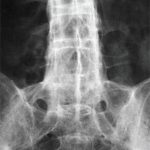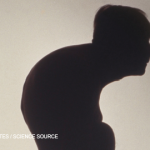In the U.S., AS was viewed as a variant of RA on the basis of a shared finding of an elevated erythrocyte sedimentation rate and the occasionally damaged peripheral joint. European clinicians argued for the distinction of AS from RA, because of its contrasting disease demographics, such as male preponderance and an earlier age of onset. In addition, the absence of subcutaneous nodules and the lack of response to gold salt therapy favored a unique diagnostic distinction. Ultimately, the discovery of rheumatoid factor and its widespread clinical application confirmed the European opinion.2
Regardless of whether one was a lumper or a splitter, a popular treatment for refractory AS was radiation therapy. The rationale for its use was best summarized by one of its major British advocates:3
There is no need to stress the tremendous economic importance of satisfactory treatment of this disease attacking as it does young men and women yet to reach their prime. The response to comprehensive radiotherapy is most encouraging and at times even dramatic. Probably it is correct to state that the results prove more gratifying than in any of the benign conditions which the radiotherapist is called upon to treat.
Sadly, it took many years and countless cases of leukemia before radiation therapy was abandoned as a treatment for AS.
The Great Wasteland
The spine is a great wasteland. After all, this sizable chunk of body real estate does not readily lend itself to a careful, critical exam. For many doctors, it fails to attain the prominence of the heart, with its complex array of murmurs, rubs, clicking sounds and palpable heaves. Palpation of the spine fails to excite the examiner the way an enlarged spleen or liver does.
Who really bothers to carefully examine the back? Last week, I had the opportunity to teach our medical students the finer points of the musculoskeletal exam. Although they were familiar with some common sense approaches to the examination of the knee or the shoulder, they were lost when we moved to the back. Yes, one can palpate the spine and marvel at its flexibility or lack thereof, but these observations often provide us with little relevant information. Is there any utility palpating the sacroiliac joints? After all, in patients with back pain, everything seems to hurt down there!
Although the students were intrigued when I pulled out my tape measure to perform the Schober’s test, they were dismayed to learn that its namesake, Paul Schober, served as a physician at a German prisoner of war camp during World War II. We ended the session by demonstrating the arcane exercise of measuring the distance between the occiput of a patient’s head and an adjacent wall. This is where Home Depot meets rheumatology. Is there a more esoteric test in medicine than the occiput-to-wall measurement?
Dawning of a New Era: HLA- B27
Our wonderful colleague, Muhammad Asim Khan, MD, professor of medicine at Case Western University in Cleveland, Ohio, embodies the best of rheumatology. A thoughtful, articulate clinician and a patient himself, he has written extensively on the topic of AS.4 Khan vividly recalls how the link was made between HLA-B27 and AS.5



